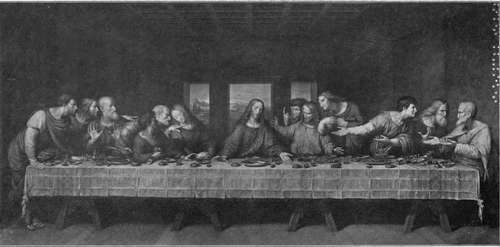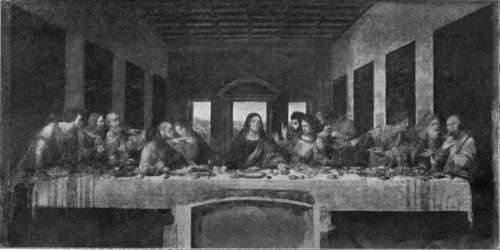The Pictures. Part 4
Description
This section is from the book "Leonardo Da Vinci", by Edward McCurdy. Also available from Amazon: Leonardo Da Vinci.
The Pictures. Part 4
The studies for the Adoration of the Magi, the cartoon for which, now in the Uffizi, was almost certainly undertaken in fulfilment of a commission from the monks of S. Donato at Scopeto in 1480, extend back in apparently almost unbroken sequence to a drawing in the collection of M. Bonnat for an Adoration of the Shepherds, which approximates in technique to the earliest work. The grouping of the central figures-the Infant Christ lying on the ground with another child, presumably S. John, bending over him, and the Virgin kneeling in adoration- would suggest a Nativity, a subject executed, according to Vasari, soon after his arrival in Milan, and sent by the Duke to the Emperor Maximilian; but the carefully individualized attitudes of the bystanders-nude, as was Leonardo's practice-show that it is connected with the other studies for an Adoration. Two of the figures, the youth on the left with his foot on a step, and the bearded man with folded arms, are reproduced with modifications in a sheet of studies of bystanders in the Valton collection. The young man who shades his eyes with his left hand recurs in a sheet of studies in the Louvre, in which the greater veneration expressed in the attitudes portrayed by the artist shows that the Magi had taken the place of the shepherds in his intention.
1 Reproduced M.-W. Bei. IV.
The kneeling figure of one of the Magi is the prototype of the figure kneeling on the right of the Virgin and Child in the Galichon drawing and the Uffizi cartoon. Above it is the nude figure of a youth bending forward in the deepest humility, which is found in reverse on the left in the Galichon drawing.
There is a sheet of studies of bystanders in the Cologne Museum which seems to be of somewhat earlier date than this drawing. The youth in tunic and buskins with arms extended, seen from behind and looking round to face the observer, occurs in simpler and more tentative rendering in the Cologne drawing, seen in front with the head turned on the shoulder.

Plate 28. The Last Supper
After the engraving by Raphael Morghen

Plate 29. The Last Supper
Alinari photo - Sta. Maria delle Grazie, Milan
On the reverse of the sheet in the Louvre are two sketches for the Last Supper, and more studies for the Adoration. These consist of a nude figure standing with head turned round in profile and left arm extended, a youth seated, and a group of two seated figures, the elder leaning on a staff listening to a youth who leans forward gesticulating with his hands, his right foot on the bench on which he sits, and the knee almost touching his chin.
The group recurs in slightly varied attitude in a drawing in the British Museum (Malcolm collection), and above are two standing figures, of whom one is blowing into the ear of the other through a long trumpet.
It is difficult to surmise how he intended to introduce this incident, and neither group is retained in the Galichon drawing.
This drawing, now in the Louvre, is of the highest value, both as marking the stage of essential completeness of conception, and for its inherent artistic qualities, for the delicacy of its texture and its unsurpassed fineness of line. In comparison with the picture in the Uffizi its mise-en-scene is more intimate. In the drawing the action took place within walls, and the terraced background is seen through an open arch. The bystanders are in comparison few. In the Uffizi cartoon they become a mighty host. The action takes place in the open air. The architecture is relegated to the background, the result being to greatly heighten the effect of distance. The pose of the Madonna is the same, but the winsome girlish figure of the drawing has put on statuesque dignity. In contrast with the plastic modelling of contour of the cartoon the bystanders seem nearer and more akin, the mystery of the Incarnation is less transcendent.
The latest in the sequence of preparatory drawings is a study in the Uffizi of the background as it appears in the picture, the angle of the terrace being reversed from that in the Galichon drawing. A camel is represented in it lying in front of the steps at the place where in the picture two sibyls are standing.
The cartoon in the Uffizi, to which all these drawings are contributory in intent, ranks, despite its inchoate condition, with the Cenacolo, the Mona Lisa, and the Virgin of the Rocks, as the greatest record of Leonardo's performance in art. Escaping the restorer by the fact of its incompleteness it contains more of Leonardo's original work than any other picture. Vasari refers to it, then in the house of Amerigo Benci, as among the best of his works, more especially as regards the heads.
Of all the renderings of the Adoration in Italian Art it is the one which approaches nearest to realizing the essential meaning of the word.
Gentile da Fabriano's picture in the Accademia, in contrast, is as a scene from a miracle play, devotional in intent and in accessories, the figures having the early Umbrian purity and solemnity,but treading their allotted parts with but little more self-subsistent vitality than wired puppets.
In the Gozzoli frescoes in the Riccardi palace the solemnity has given place to a masque of quaint conceits. The pageant is frankly Florentine. As the gay cavalcade winds by, we think no whit the more than the riders of what they have set out to see.
Botticelli's most famous Adoration is charming as a portrait group of the Medicis, who are all turning their heads away from the Madonna and Child in order to be seen by the spectator. There is no more adoration in the whole group than there is humility in the figure of Sigismondo Malatesta, in the fresco at Rimini, kneeling before the saint who is his namesake.
Continue to:
Tags
leonardo da vinci, pictures, drawings, galleries, statues, da vinci
